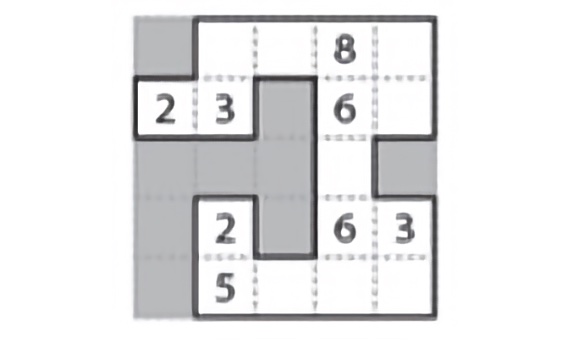One of the most heated debates in the field of anthropology revolves around when and how our ancestors mastered fire. The controversy also extends to when they began to plan the best place to establish the communal fire hearth within caves, in order to minimise risk and maximise its potential. In many of these caves, evidence has been found of a fixed location for the fire: it was lit in the same place for many years. Was this a chance choice, the result of custom and tradition, or a planned decision?
Game 1: Discover the prehistoric cave
Cave is a type of puzzle game devised by the Japanese company Nikoli in 1996. The rules of the game are simple: shade some cells to leave a single connected group (the cave) with no shaded cells enclosed in it. In other words, all shaded cells must be connected by at least one edge to other shaded cells, or to the edge of the grid. All numbered cells are part of the cave. And each inscribed number indicates the total count of cells connected vertically and horizontally to the numbered cell, including the cell itself.
Example:

This is the board with the cave hidden:

Although today we are able to light fire at will and understand its capabilities and dangers, how far back in the evolutionary process does this knowledge go? This question has sparked much scientific debate in recent times, especially after a 2019 study showed that the optimal location of a fire hearth for minimal smoke exposure is towards the back of the cave.
This location allows hot, smoke-laden air to escape to the outside against the ceiling of the cave, while cool, clean air from the outside circulates at the back. However, in many of the caves analysed, the hearth was located in the central part of the cave, which points to a lack of planning or perhaps ignorance.
Game 2: Illuminate another prehistoric cave

However, a more recent study by researchers from the archaeology department of Tel Aviv University—ironically, the same researchers who conducted the 2019 study— concludes, on the contrary, that the central location is the best decision, and that our ancestors were well aware of this.
This study, published in Nature, focused on the French cave of Lazaret, inhabited by Homo heidelbergensis and Homo Neandertalensis during the late Lower Palaeolithic period (around 170,000 to 150,000 years ago). Using computer simulations, they analysed the effect of lighting a fire in 16 different potential locations distributed throughout the cave—including the back and central parts of the cave, where the remains of the prehistoric hearth are located—in relation to the dispersion of smoke. From this information, they checked the location of habitable or working spaces, i.e. those areas of the cave where it was possible to stay for a long time without risk of smoke inhalation.
This more comprehensive analysis led to the conclusion that establishing the hearth at the back of the cave is not actually the most suitable location. Although it is the most optimal in terms of ventilation, it also means that the spots where the smoke density drops to levels suitable for continuous activity are located quite far away from the source of heat, which is not practical to take advantage of all the benefits of fire. In fact, according to the study, if both factors are considered together—daily activity and smoke dispersion—the best area to establish a fire is the central part of the cave. This is precisely where the remains of the “perennial” hearth of the Lazaret cave is located, which also corresponds with most of the other caves from the same period considered in the study.
In this way, the authors of the study determined that Neanderthals and their European ancestors of 170,000 years ago were already aware of the benefits of fire, but also of its risks, and planned the optimal place to establish the hearth in order to maximise the former and reduce the latter. This evidence is even more incredible when seen in perspective. As science populariser Bill Bryson recounts in his work At Home: “One thing that did not escape notice in medieval times was that nearly all the space above head height was unusable because it was so generally filled with smoke. […] What was needed was something that would seem, on the face of it, straightforward: a practical chimney. This took a long time to happen…”
Game 3: An even more extensive cave to work through

Solutions
Miguel Barral

Comments on this publication